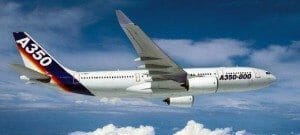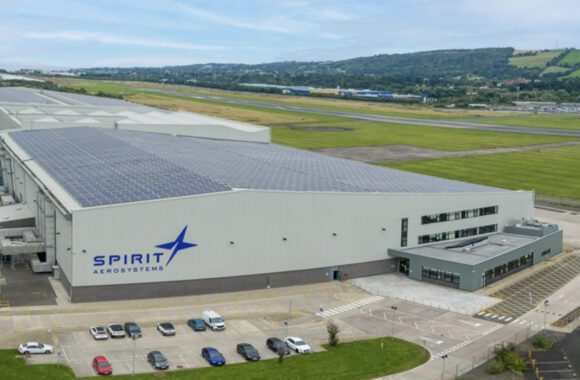When we published the post titled “Is It Time for a 767NG?”, we heard the idea was met with amusement in some quarters. Well, we can’t resist the idea of laying out another idea for our audience’s further amusement.
Looking at the middle segment, the big twins, one can see this market is attracting a lot of attention. The pending order from Air France/KLM is almost certainly going to focus on the 787 and A350. The talk of a large order from the Lufthansa Group is likely to also focus on this segment as it considers replacing its early A340s and other similar generation aircraft in its growing airline family. Between these companies, they could bottle up segment production slots for some time. Indeed, as we learned, the earliest A330 delivery slots available are in 2014, a date that quickly slides to the right.
The first A350 slots now available are from 2019.
So what do airlines that are not defined at Tier 1 do as they consider their own fleet updates? After all, these airlines pay the same high fuel prices and face the same MRO costs of older airplanes. The lack of near term delivery slots for 787s (also around 2019) and A350s may provide an opportunity for a magical interim step.
The big twin segment, between 225 and 325 seats, is a sweet spot. Boeing’s 767 cleaned up in its day. Then along came the A330 and took the business. The 787 remains essentially in this size category while Airbus’ A350 tends to a larger size. Airbus appears comfortable that it can hold the lower end with the A330. And they could have a point. The A330 has grown more effective with upgrades and remains a highly popular airplane among airlines. This interest provides evidence that the segment is the right size for many airlines.
Airbus has forfeited the lower end of the middle market to Boeing by choosing to offer the A350 as primarily a 777 competitor. The A350-800 competes with the still-to-be developed 787-9, but the 787-8 has the new technology market all to itself and has sold more than 500 aircraft. As good as the A330-200 is, it is older technology and despite the range/payload improvements, once you get past 787 Line 80, the “Lead Sled” 787 disappears and the airplane out-performs the A330-200 on efficiency and cost (though not on revenue, since the A332 is larger).
Airbus has demonstrated that by starting with essentially a current design, and adding the latest engines and other technology updates, it is able to offer customers a relatively low risk improved economic solution, sooner. Airlines are risk averse, and long lead times cause schedule upsets and these have trickle down impacts. Hence the public demands for delay compensation from 787 customers. And this is probably a good reason airlines are scrambling for A320neo – it is seen as a low risk solution to a current problem with EIS far sooner than a new design. Airlines have learned from the 787, 747-8, A380 programs – new planes are horribly complex. This almost guarantees delays, and delays of any sort mean bad news for airlines.
So in that light, why does Airbus not follow upon its current A320neo success? This could be an excellent time to propose an A330neo. It would serve to protect Airbus’ customer base from defecting to the 787. (There have already been public grumblings about an A350 delay – easily ignored for now, but still)
What does an A330neo need to offer, for example, how about a 15% better fuel burn? Well, for a start, we have seen something like this before, haven’t we? The image is a reminder. It is worth noting Air Asia has been talking about an A330neo. As the biggest A320neo customer, this is an opinion worthy of some attention.

There are new engines from GE (GEnx). P&W has openly spoken of its GTF technology being able to go as high as 100K thrust. In addition, Rolls-Royce has a revised Trent coming for the A350 – no doubt there are tech inserts that can be put into the current A330-sized Trents. So around the 70K thrust category already offers good choices. An A330-200 with the Pratt & Whitney GTF could reasonably reduce SFC by 12%-15% (assuming similar performance for the smaller GTF) and DOC by half of this, exclusive of ownership costs. A 6%-7.5% DOC improvement coupled with the greater revenue potential of the A330-200 would make the A330-200neo highly competitive and protect Airbus’ presence in the lower middle market.
Airbus is in a very good situation here – it could offer three engine choices and it is worth noting the A330 has always offered engines from all three engine OEMs. Moreover, as Airbus builds its own engine pylons, it could readily standardize the pylon (a la 787) and save itself and engine OEMs development costs. Not to over simplify the development, but it certainly appears less expensive than any new design and could follow the current A320neo learning curve.
Besides engines, we could see sharklets. We have seen how winglets give the 757 a new lease of life and now many 767s now also sport them. That will almost certainly save 2% in fuel burn. There are new flight deck enhancements from the A380 and some ideas can be borrowed from the A350. There are also newer materials that can be deployed – and Airbus has a very clever modular galley that is much lighter which can be made standard.
Besides the attraction of the A330neo for Airbus, this interim step serves to allow the firm to develop its A350 under less pressure. Although the A350 program now seems to be running a bit later – note the lesson learned from the A380, A400M and, yes, even the 787. Airbus is being open and transparent about the delays early. The irritation comes and goes – no more drip-drip-drip water torture as with the earlier programs.
If an A330neo were offered for sale promising 15% better fuel burn (as well as lower emissions and noise) we believe many airlines would jump at it. There are numerous airlines for which the high tech 787 and A350 may be simply too much technology to cope with. We also think lessors would feel the same way because it is their asset in the hands of airlines that may not have the capital to buy new planes even though they need them and leasing is the better option.
The A330 is “right sized” for many markets. It would offer the newest technologies without the risk of totally new programs. Airbus could probably also earn more per sale as it plans to do with A320neos. For the first time in a while, Airbus is priced higher than Boeing. And the A320neo is outselling Boeing in its segment by an eye popping margin. Airbus has found a formula that promises much and apparently comes with less risk in the eyes of the market. It could be a formula to try again.
An interim solution is not a silly idea. Look at the roaring success of the A320neo. It would be fair to say the demand has taken even Airbus by surprise . (“When I went to the board last year to have approval for the A320neo, I promised strong sales for many years forward with the family,” said Tom Enders, Airbus President and CEO. “But at this point of time, I have to admit, I didn’t think it would be such a best-seller in only six months after the launch.” PAS 2011) Even if no big customer switch has taken place, the signal the OEMs have received is that airlines want a single aisle solution sooner rather than later. Some customers want a completely new design from Boeing. Given that its core 737 design dates form 1967, that is understandable. The A320 is younger by some two decades and therefore neo has proven to be a runaway success. The chart below illustrates what we call the “neo effect”. The chart shows that the neo is trumping not only regular A320 sales, but it is also massively outselling the 737. This can only serve to demonstrate that airlines are, dare we say desperate, or at least very keen, on a lower fuel burn solution. 
Views: 5





I wonder if A320NEO sales come with the option to switch to an Airbus equivalent to the Boeing NSA (when announced).
What would the EIS of an A330neo be? How would it compare to the A358? Would it kill it completely? Would it force Airbus to abandon the -800 and focus the A350 on the 777-size market?
My first thought is does EADS/Airbus have the engineering resources to be able to develope an A-330NEO along side of the other developement programs they currently have? If they do, how soon could they begin delivering them?
Current engineering programs going on at EADS/Airbus include the A-380, and when, if ever they are going to develope the A-389 and A-388F, of course three models of the A-320NEO, differing versions of the A-330MRTT, and the blended winglets (Sharklets) for the A-32X and A-330 series, and of course the resource consuming A-400M program. That is a lot of programs on their plate.
Then they will need to give the engine OEMs time to develope the new engines, or ‘tweek’ the current TRENT-700. Looking at an A-330NEO this way, I just don’t see it beginning flight testing until about 2017-2018, or even later if they decide on things like a new wing or composites added to the fuselarge.
Boeing is facing a similar problem with the lack of engineering resources because of the B-788/9, B-747-8F/I, KC-46A, B-737MAX, and B-777X programs.
I know I’m replying on an old topic. The A330neo rumours however, never seem to go away. Most importantly since rumours of A350-800 cancellation are getting stronger. But airbus won’t do a A330neo. Why do a A330NEO if you can do more? A350 cockpit and tail might have the possibility to integrate with a new A330. And there’s a lot more you can inherit directly from the A350. Those are cerified pieces which might need only minor adaption work. But first, the A350 has to fly. Wait and see.